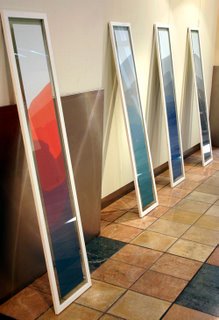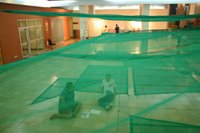Wong Hoy Cheong : Can you begin by telling me more about this exhibition? Why the Australian High Commission (AHC)? How did you come up with the theme for your exhibition, and why the title Fourth World?
Sharon Chin : Well, the AHC approached me sometime last year to make a work in their space. They mentioned they were especially keen on having an installation. I assumed this meant a site-specific work, something that interacted with the space.
I approached this show with ships on the brain! Around that time I had been reading Patrick O’Brian’s series of sea-faring novels set during the Napoleonic wars. It was the golden age of sailing. To me, those ships were a perfect way to explore ideas of journeying and location – both literally and symbolically. A ship is like a mini country made of hollow oak, afloat in a vast expanse of ocean. It always departs from and arrives at a specific place, but in the course of the journey, belongs wholly to itself.
WHC : Did this idea of a ship, this microcosmic world afloat on water, emerge from the site-specificity of AHC, or was it, as you said, a personal obsession?
SC : It certainly started with obsession. My long-suffering friends were very puzzled. I would spontaneously break out into rants of naval trivia, totally boring to anyone but myself. After I visited the site a few times though, things began to take shape more formally – in terms of how to explore what the AHC actually is through the language and idea of ships. Basically I had to get more serious about things!
As for the title
Fourth World, I wanted something that reflected a state of becoming or transition – in-between-ness, if you like. We’re familiar with First, Second and Third Worlds, and while Fourth World isn’t widely known, it does exist. Various people have claimed it for themselves – some use it to denote countries of extreme poverty, others to define indigenous communities displaced because of colonization. I think often people define themselves through the labels that are given them. Take Malaysia, we are called Third World and we call ourselves Third World – we are defined by this idea, it makes us who we are. We get lazy and stop the act of self-definition, self-questioning. These notions seem so naturalized, that they become invisible. What I want to do is to make the process, language and structure of naming, of labeling, visible.
WHC : I am interested in how you have put together a few inter-related ideas – in the title Fourth World, you suggest that labels can in fact cripple the process of transformation; in the ship as metaphor, you talk of journeying as a transitory state. But how does the AHC as a site feed into your ideas and works? What is site-specific? After all, the AHC is also a site loaded with power.
SC : Certainly. The AHC is by no means a neutral site. It is, as you say, a place of power. It is also a site of transition, an in-between space where you go to before departure. One of the central ideas in the show is about access; physical access to places in terms of gaining entry, and how that access is granted or denied.
WHC : Embassies possess power. With this power, they can act both on your physical and mental body.
SC : Yet a space that acts upon us can also be acted upon by us. Often, the way certain spaces exercise their power is invisible, just like the act of labeling. Understanding how a site or label acts, allows us to act on it ourselves. It gives us the language. Think about the term ‘globalization’. How do you explain to a person that their village has to be decimated to make way for a hydroelectric dam? Is s/he going to understand ‘globalization’? To describe a process of power, one word or phrase is never enough.
WHC :
Embassies and ships exist everywhere. Similarly, terms that define economic and political status are used internationally. I see a parallel between the choices of materials and images in your works. Images of sails, knots, and shorelines, as well as materials such as construction netting, cement, and seawater are also understandable globally. Can you talk about the relationship of materials to your concept?
SC : I think materials in themselves have a language. And it is a democratic language in the sense that everyone has a reaction to materials – whether by sight, touch, taste or smell.
Living in and working in KL, I sometimes feel the material of the city seep under my skin. There have been moments when I felt the whole city would crumble under the weight of concrete and a hundred thousand cars stuck motionless in the 6pm jam. All of us, from commuters, to construction workers to architects have some kind of experience and contact with materials like concrete and scaffolding – this is the stuff of our landscape. I want to bring us into closer contact with this stuff, to allow a deeper mental understanding by physical confrontation.
WHC : In the context of art in Malaysia, materials like concrete and construction netting are often seen as peripheral to art-making. They do not belong to dominant notions of art materials like paint and charcoal. How do you feel that your work is valid as art? How are you going to convince the public that these global, everyday materials possess a language; a democratic language at that?
SC : If you think about it, charcoal isn’t too far off from concrete. If we can make charcoal speak a certain way, and that language is beautiful and valid, why can’t we make concrete speak a certain way? Why not scaffold netting? It’s about translation and language. I don’t use charcoal because its language does not say what I want to say – I know maybe about 5 words with charcoal. After months of playing with concrete, seawater and cement, I know 500.
I feel materiality is not explored enough in Malaysian art. With paint – maybe, but there is little discourse around other materials, or the idea of materials. There are plenty of instances of artists bringing ‘everyday’ or ‘found’ objects into art – e.g. look at me put a rusty crowbar on my painting, etc. But really that ‘found’ object seldom retains its own integrity as a material thing. What remains is a surface symbolism that is disposable and convenient.
WHC : Having taught art in Malaysia, I agree. There is little discourse and critique of the assumptions around materials, the meaning and context of materials and their materiality. But materials only become resonant through the process of translation or transformation. Can you talk more about this?
SC : The key word here, I think, is ‘process’. Can we say most art starts with an idea? If so, we often look for and subject materials to the realization of this idea. But as you experiment and play, the physicality of the material begins to exert its own rules. Concrete naturally wants to lie on the ground. It NOT does happily hang in the air, suspended by fishing line. Do you hang on rigidly to your idea, or do you allow the way a material acts to influence and change your idea? I’ve always found the latter works best for me.
WHC : I think you are talking about the visceral process where the physical act of working through materials feed into the ideational and conceptual, and vice versa. This leads us to the issue of the artist’s gesture and touch, handmade-ness, and the craft of art-making. How pertinent is it in this time and day?
SC : Ah, the ‘Craft’ Question! I think it’s no longer all that relevant in the context of global currents of contemporary art, though it does surface now and again to say hello. In Malaysia however, it remains a point of discourse – questions about the value of art, technique and so on still seem to be quite important.
My take on it is that there is a close relationship between art and action. I love this quote by Yukio Mishima, one of my favorite writers: “
Never in action had I experienced the chilling satisfaction of words, never in words had I experienced the hot darkness action”. A lot of my work is an accretion of simple gestures and actions. French artist Annette Messager once said she likes an ‘economy of means’. So do I. Acts like hanging, pouring, tying and dipping are democratic and anonymous. They are easily understood and approached, yet are full of potential for poetry and sophistication. Elizabeth Presa (an Australian sculptor I greatly admire and am very much influenced by) uses these methodologies extremely well. I do not like to conceal the touch of the hand in my work. I want people to know at a glance how it has been made. But don’t mistake me, I’m not talking about the expressionistic gesture!
WHC : Let’s move on to something quite different. You are one of the few visual artists who also write. Why do you write?
SC : I think as much writing as possible is needed here in Malaysia, for documentation as much as anything else – how will we have an art history if no one writes?
An artist writing on art could be seen as a conflict of interest, I guess. I try to make clear the position I am coming from. I feel I approach things in terms of the intentions of the artist, and how successfully or unsuccessfully they have translated into the work. This is where art criticism comes in - how sometimes an artist has such fantastic intentions and the catalogue essay is brilliant, but the work falls short. I think what is really missing here are critical evaluations. We have a lot of “this artist wanted to do this”, and art writing revolves around celebrating the intentions but does not delve into whether the artist has achieved what s/he set out to do.
A pet peeve of mine is that there is far too much space devoted to the description of an artwork in art writing. We are getting art reportage, not criticism!
WHC : In a recent review in Off The Edge (pg.64, Issue 16, April 06), you wrote: “…we seem to be much concerned with having as many dialogues as we can about the same discourses, instead of questioning how these discourses come to be staged, and how they become powerful and dominant.” Another artist-writer, Safrizal Shahir also argued along similar lines in Sentap (pg.8 – 9, Issue 02, Nov 05 – Feb 06) – that we do not have, and deny ourselves, of learning, understanding and utilizing the language of contemporary art, and therefore are crippled in our partaking of global contemporary art discourse. It seems that to me this is the crux of the problem in art discourse. Can you talk more about this?SC : These are questions of language, discourse, tools… and their power. I think unconsciously we problematize this idea of ‘global contemporary art discourse’. We don’t want to seem derivative. It seems we want a distinctly
Malaysian art discourse. We want roots, we want to
boleh all on our own. But we forget that ideas in and of themselves are democratic things – it’s not about being ‘Western’ at all. By using the discourses that are available, wither they be ‘Western’ or ‘Middle Eastern’ or whatever, we are trying to explore things that are important and contemporary to us now. We think that by using the ‘their’ language of contemporary art, we would become the nail, when in fact, we would be picking up the hammer!
Wong Hoy Cheong is a visual artist who exhibits in Malaysia and abroad. He occasionally curates and writes.




























